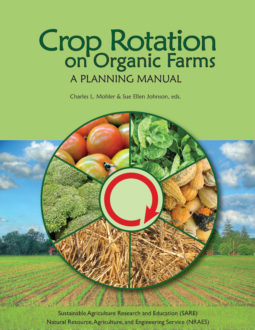by Sue Ellen Johnson
Most experienced organic farmers have a good grasp of the biological principles of crop rotation (see sidebar 4.1). Considering an organic farm field with a healthy, high-yielding crop, the natural question is, what cropping history (or crop rotation) contributed to its vigor and productivity?
Chapter 2 reviewed the multiple interacting factors that experts balance as they manage crop rotations. This chapter presents crop sequences for actual fields, as implemented by expert organic farmers on their own farms. Twelve expert farmers each recounted the four- or five-year cropping history of one real field on their own farms at a 2002 workshop (see Chapter 2). Cropping sequences used by four additional expert farmers are also included to better represent the range of crops and farm types in the northeastern US. All of the farms whose field sequences are presented in this chapter were nominated as exemplary by organic certifiers or other organizations that work with organic farmers. (The farmers are described in sidebar 4.2)
The examples in this chapter are illustrations, not recommendations. The farmers emphasized that these sample sequences may not be (and probably are not) directly transferable to other farms.
These cropping histories illustrate the use of rules-of-thumb (sidebar 4.3) and the prevalence of crop couplets and short sequences. The farmers developed these couplets and short sequences using observation, cumulative knowledge, judgment, and trial and error under real farm, field, and seasonal conditions. Many sequences continue to evolve as the farms themselves do.
Although whole-farm requirements of cash flow, market demands, equipment, and labor availability set the priorities that guided the development of these sequences, the rationale underlying each sequence is based on the needs of each particular field. Another major element influencing each rotation is the total land area that the farm has available for cropping (see sidebar 2.4). Although a few sequences may occur on multiple farms, the market goals and farm logistics guiding them may be different in each case. Several farms achieve similar biological goals with different sequences of crop families.
